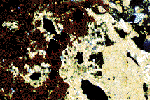
The carbonates represent a very active phase, as they remain affected by pedogenic processes, for which they frequently show a determined evolutional tendency.
In general, as time passes, carbonates are going to accumulate subsequently in specific horizons. The type of accumulations, their morphology as well as the resulting genetic processes are going to change with the age of the soil.
A common chronosequence in the soils is as follow:
---------- AGRADATION ---------> |
DEGRADATION | |||
Stage 0 |
Stage 1 |
Stage 2 |
Stage 3 |
Stage 4 |
----------- AGE ----------> | ||||
Carbonates completely absent |
MORPHOLOGY: thin hypo-coatings, discontinuous and scarce PROCESS: crystallization |
MORPHOLOGY: thick hypo-coatings, continuous and abundant PROCESSES: crystallization and recrystallization |
MORPHOLOGY: groundmass PROCESSES: crystallization, recrystallization, replacement and deplacement |
The carbonates are eliminated by dissolution. This normally takes place in the higher horizons of the soil, the eluvial horizons, but occasionally also in the deeper horizons, wich are under normal conditions accumulation (i.e. illuvial) horizons. In some cases the carbonates, previously accumulated in the deeper horizons, may be eliminated later, e.g. due to a climatic change. Such a change can result in an increase of water percolation or the truncation of the soil by erosion. In both cases the upper part of the illuvial horizon becomes included now in the eluvial zone. |